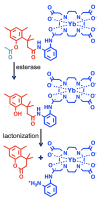A self-calibrating PARACEST MRI contrast agent that detects esterase enzyme activity
- PMID: 21861282
- PMCID: PMC4879975
- DOI: 10.1002/cmmi.421
A self-calibrating PARACEST MRI contrast agent that detects esterase enzyme activity
Abstract
The CEST effect of many PARACEST MRI contrast agents changes in response to a molecular biomarker. However, other molecular biomarkers or environmental factors can influence CEST, so that a change in CEST is not conclusive proof for detecting the biomarker. To overcome this problem, a second control CEST effect may be included in the same PARACEST agent, which is responsive to all factors that alter the first CEST effect except for the biomarker to be measured. To investigate this approach, a PARACEST MRI contrast agent was developed with one CEST effect that is responsive to esterase enzyme activity and a second control CEST effect. The ratio of the two CEST effects was independent of concentration and T(1) relaxation, so that this agent was self-calibrating with respect to these factors. This ratiometric method was dependent on temperature and was influenced by MR coalescence as the chemical exchange rates approached the chemical shifts of the exchangable protons as temperature was increased. The two CEST effects also showed evidence of having different pH dependencies, so that this agent was not self-calibrating with respect to pH. Therefore, a self-calibrating PARACEST MRI contrast agent can more accurately detect a molecular biomarker such as esterase enzyme activity, as long as temperature and pH are within an acceptable physiological range and remain constant.
Copyright © 2010 John Wiley & Sons, Ltd.
Figures









Similar articles
-
Ytterbium chelated to 1,4,7,10-tetraazacyclododecane-1,4,7-triacetic acid,10-orthoaminoanilide.2011 Nov 26 [updated 2012 Jan 5]. In: Molecular Imaging and Contrast Agent Database (MICAD) [Internet]. Bethesda (MD): National Center for Biotechnology Information (US); 2004–2013. 2011 Nov 26 [updated 2012 Jan 5]. In: Molecular Imaging and Contrast Agent Database (MICAD) [Internet]. Bethesda (MD): National Center for Biotechnology Information (US); 2004–2013. PMID: 22238803 Free Books & Documents. Review.
-
Improved pH measurements with a single PARACEST MRI contrast agent.Contrast Media Mol Imaging. 2012 Jan-Feb;7(1):26-34. doi: 10.1002/cmmi.460. Contrast Media Mol Imaging. 2012. PMID: 22344877 Free PMC article.
-
Design and characterization of a new irreversible responsive PARACEST MRI contrast agent that detects nitric oxide.Magn Reson Med. 2007 Dec;58(6):1249-56. doi: 10.1002/mrm.21428. Magn Reson Med. 2007. PMID: 18046705
-
Using two chemical exchange saturation transfer magnetic resonance imaging contrast agents for molecular imaging studies.Acc Chem Res. 2009 Jul 21;42(7):915-24. doi: 10.1021/ar8002738. Acc Chem Res. 2009. PMID: 19514717 Free PMC article.
-
Eu-1,7-Bis(2-(methylene benzyloxy ether)-acetic acid) acetamide-4,10-bis(acetamidoacetic acid)-1,4,7,10- tetraazacyclododecane.2009 Feb 19 [updated 2009 Mar 10]. In: Molecular Imaging and Contrast Agent Database (MICAD) [Internet]. Bethesda (MD): National Center for Biotechnology Information (US); 2004–2013. 2009 Feb 19 [updated 2009 Mar 10]. In: Molecular Imaging and Contrast Agent Database (MICAD) [Internet]. Bethesda (MD): National Center for Biotechnology Information (US); 2004–2013. PMID: 20641846 Free Books & Documents. Review.
Cited by
-
Detection of in vivo enzyme activity with CatalyCEST MRI.Magn Reson Med. 2014 Mar;71(3):1221-30. doi: 10.1002/mrm.24763. Magn Reson Med. 2014. PMID: 23640714 Free PMC article.
-
Membrane-Permeable Mn(III) Complexes for Molecular Magnetic Resonance Imaging of Intracellular Targets.J Am Chem Soc. 2016 May 4;138(17):5483-6. doi: 10.1021/jacs.5b13337. Epub 2016 Apr 22. J Am Chem Soc. 2016. PMID: 27088782 Free PMC article.
-
Assessments of tumor metabolism with CEST MRI.NMR Biomed. 2019 Oct;32(10):e3943. doi: 10.1002/nbm.3943. Epub 2018 Jun 25. NMR Biomed. 2019. PMID: 29938857 Free PMC article. Review.
-
A new paramagnetically shifted imaging probe for MRI.Magn Reson Med. 2017 Mar;77(3):1307-1317. doi: 10.1002/mrm.26185. Epub 2016 Feb 28. Magn Reson Med. 2017. PMID: 26922918 Free PMC article.
-
Detection of Sulfatase Enzyme Activity with a CatalyCEST MRI Contrast Agent.Chemistry. 2016 May 4;22(19):6491-5. doi: 10.1002/chem.201600685. Epub 2016 Mar 23. Chemistry. 2016. PMID: 26956002 Free PMC article.
References
-
- Zhang S, Merritt M, Woesner DE, Lenkinski RE, Sherry AD. PARA-CEST agents: modulating MRI contrast via water proton exchange. Acc Chem Res. 2003;36(10):783–790. - PubMed
-
- Yoo B, Pagel MD. An overview of responsive MRI contrast agents for molecular imaging. Front Bioscience. 2008;13:1733–1752. - PubMed
-
- Ward KM, Balaban RS. Determination of pH using water protons and chemical exchange dependent saturation transfer (CEST) Magn Reson Med. 2000;44(5):799–802. - PubMed
-
- Aime S, Barge A, Delli Castelli D, Fedeli F, Mortillaro A, Nielsen FU, Terreno E. Paramagnetic lanthanide(III) complexes as pH-sensitive chemical exchange saturation transfer (CEST) contrast agents for MRI applications. Magn Reson Med. 2002;47:639–648. - PubMed
Publication types
MeSH terms
Substances
Grants and funding
LinkOut - more resources
Full Text Sources
Medical
